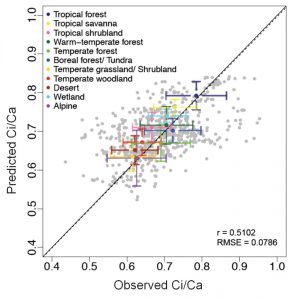
Laying the foundation for a new generation of models
Dynamic global vegetation models (DGVMs) were first conceived at IIASA twenty-five years ago and have since become indispensable for understanding the biosphere and estimating ecosystem services. However, while their versatility is increasing as new processes and variables continue to be added, their accuracy suffers from the accumulation of uncertainty, especially in the absence of overarching principles controlling their concerted behavior.
The crosscutting IIASA project Dynamic vegetation models: The next generation (DVM) aims to address this problem by developing the foundations of a new generation of models centered on a ‘missing law’ – adaptation and optimization principles rooted in natural selection. Even though this missing law constrains relationships between traits, and can therefore vastly reduce the number of uncertain parameters in ecosystem models [1], it has rarely been applied to DGVMs. The project is working towards operationalizing this concept through scientific discussion and research collaboration in an international working group of leading experts from multiple disciplines coordinated by IIASA.

A model of trait evolution and species coexistence recovers natural vegetation patterns from around the globe.
The project utilizes the convening power of IIASA to attract a wide range of members of the international scientific community of vegetation modelers to discuss and evaluate state of the art models, current limitations, and promising ways forward. Building on results of a recent DVM workshop, two papers are being prepared. The first of these is a review laying down a roadmap for the next generation of vegetation models, while the second is a perspective paper assessing the power of overarching organizing principles, including those of adaptation and optimization, for improving vegetation models.
Several studies have been conducted to explore these new concepts. These include an optimization-based photosynthesis model published in Nature Plants [1], a new model for adaptive tree growth [2], a study of the global effects of leaf optimization [3], an adaptation-based model of forest trait diversity published in PNAS [4], and a comment on mycorrhizal effects on global CO2 fertilization published in Science [5].
The findings of the above studies demonstrate the potential of adaptation and optimization principles for modeling plant and forest dynamics. In one of the studies, for example, researchers developed a model of trait evolution and species coexistence that recovers natural vegetation patterns from around the globe [4]. In this model, plant species inhabit a metacommunity of patches and differ in two functional traits, namely leaf mass per area and height at maturation. After a disturbance, vegetation development in a patch follows successional dynamics under height-structured competition for light. The upper panel of Figure 1 shows the height of individual plants in a diverse community of species (colors) in a patch in the wake of a disturbance. The lower panel in turn, shows the corresponding prevalence of species (left vertical axis and colored areas) as the probability that a patch remains undisturbed decreases (right vertical axis and black line) for an average interval between disturbances of 60 years.
Using uniform parameters in conjunction with a least-cost optimality hypothesis, another model developed by researchers from the project predicts photosynthesis and associated leaf-internal-to-ambient CO2 partial pressures for multiple biomes (Figure 2). This model is driven by temperature, vapor pressure deficit, and elevation. The figure compares model predictions with observations from the global delta 13C dataset, with means and standard deviations indicated for each biome (colored lines). The model explains the observed variation among biomes, as shown by the resultant regression line (continuous black line constrained to pass through the origin), which is very similar to the 1:1 line (dashed black line) [1].
References
[1] Wang H, Prentice IC, Keenan TF, Davis TW, Wright IJ, Cornwell WK, Evans BJ, & Peng C (2017). Towards a universal model for carbon dioxide uptake by plants. Nature Plants 3 (9): 734-741.
[2] Fransson P, Brännström A, & Franklin O (2018). A tree’s quest for light – Optimal height and diameter growth under a shading canopy. American Naturalist, in revision.
[3] Peaucelle M, Viovy N, Augrit P, Goll DS, Maire V, Verheijen LM, Bodegom PM, et al (2018). Coordinated adaptation of foliar resource allocation affects the projected CO2 fertilisation of terrestrial ecosystems. Nature Climate Change, in review.
[4] Falster DS, Brännström A, Westoby M, & Dieckmann U (2017). Multitrait successional forest dynamics enable diverse competitive coexistence. Proceedings of the National Academy of Sciences of the USA 114 (13): 2719-2728.
[5] Terrer C, Vicca S, Hungate BA, Phillips RP, Reich PB, Franklin O, Stocker BD, Fisher JB, & Prentice IC (2017). Response to Comment on “Mycorrhizal association as a primary control of the CO2 fertilization effect”. Science 355: 358.
IIASA Contributors
Further information
Other highlights
Top image © Guenter Albers | Shutterstock








You must be logged in to post a comment.